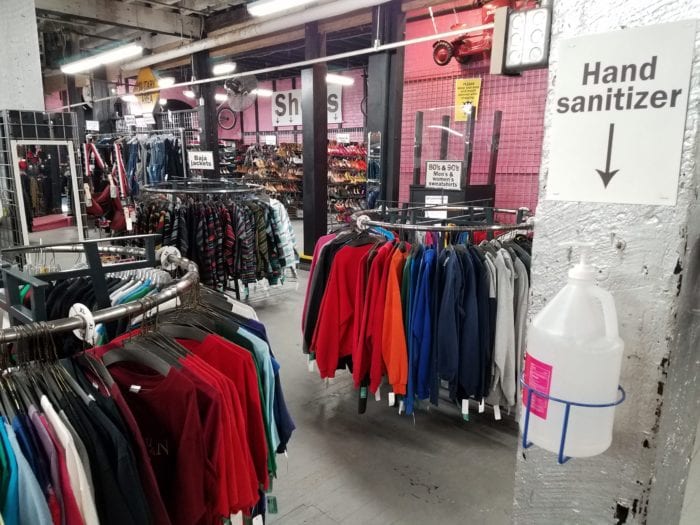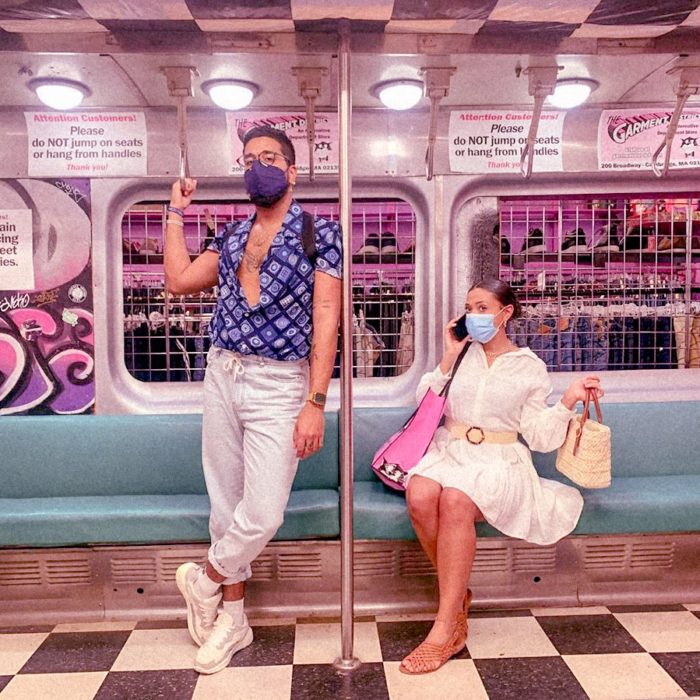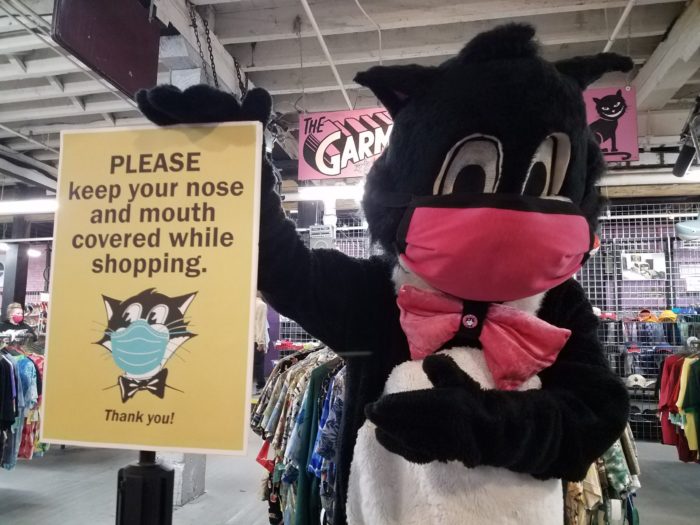
“Together we got through the economic crisis after 9/11 and the financial crash of 2008. With a little luck and perseverance, we will find a way to survive this crisis too.”
About 10 minutes by foot from the Kendall Square T station, past rows of gleaming office buildings, is a renovated 19th-century factory painted with a bismuth pink stripe. The bold accent is just a taste of the candy-colored interior of the building housing both the Garment District and Boston Costume.
A mainstay of the Greater Boston vintage and secondhand clothing scene since 1986, the Garment District has hosted generations of shoppers in search of that perfect piece to set their outfit apart, fostering the style evolution of many lifelong vintage enthusiasts, myself included.
Unique for its longevity as well as its extensive inventory, the Garment District has survived many a national crises as an independent business. Even before the pandemic, it outlasted innumerable vintage boutiques, including the once-ubiquitous consignment chain Second Time Around.
With Boston entering Phase 3 of the reopening of Massachusetts plan this month, we interviewed owner Chris Cassel about how the Garment District stays afloat and what can be done to see this landmark through COVID-19’s treacherous waters.
From Harrods in London to Cambridge, Massachusetts, how did you arrive at the Garment District?
This was all a long time ago now. A career in fashion wasn’t really something that was planned. I went to school at Boston University and studied film. Right after, I ended up living in the UK for a few years and landed a job at Harrods. I wasn’t really the Harrods type. I got in trouble for wearing shorts and cowboy boots in public view—not the look they wanted.
I did most of my work behind the scenes doing things like finding lost living room sets for the royals. The place was so huge that, yes, you could lose living room sets in it. When I moved back to Boston, I had some friends who worked at this newish place called the Garment District. I got hired and I never left. In the ’90s I was the general manager. When the original owners retired in 1999, a small group of employees helped me buy the place, and we are all still here today.

How have you seen the vintage and secondhand clothing market change since then, and especially throughout the past year?
Since the 1980s the vintage and secondhand clothing market has changed a lot and it is still changing. Over the last 30 years the biggest change is that the industry has moved almost entirely overseas. When I started there were small businesses dotted all over Boston and the suburban area sorting and processing used clothing. There was a huge grinding mill out in Western Massachusetts that ground fabric down to its base components. In Worcester, there was a huge sorting facility. Here at 200 Broadway in Cambridge, we cut clothing into rags for industry. Almost all of that is gone. Like many industries it became cheaper to ship clothing around the world and sort and cut the clothing elsewhere. The Garment District is one of very few places left that sorts used clothing in the state.
The newest trends have been online. Several venture capital-funded places are trying their hand at selling used clothing online. Some have already failed. Others might succeed. At the upper end of the market where prices are high, I imagine this might take off. It’s hard to do, though. Clothing is so dependent on fit and color. Most traditional online retailers carry less than a hundred items in a season. By definition in used clothing every piece is unique. It creates a lot of challenges, but it’s a new generation. Who knows.
In terms of this year? Well, it’s nearly impossible to survive. We are cautiously optimistic we can make it through—but who knows. Without the good will of our customers and financial assistance from the government we would not have survived this far.
Has anything remained the same?
For the most part, the charitable organizations who handle and sell used clothing like Goodwill and Salvation Army are the same.
What have been the Garment District’s biggest challenges while operating during the pandemic?
At first it seemed very frightening. Once we were allowed to reopen, we knew so little about how the disease spread and how to stay safe. But after installing plexiglass, getting used to wearing masks and social distancing, it feels comfortable now. We’ve also had great cooperation from our customers. Thankfully the staff has stayed healthy. So, knock on wood, it has been reasonably smooth.
It’s been said that millennials are responsible for the death of the traditional department store; what do you think keeps attracting younger customers to the Garment District?
Do you want to look exactly the same as the person next to you? We sell a product nobody else has. You can come in and find something one of a kind. Why go to the mall when you can find all the same stuff online?
With over 13k followers on Instagram, have you found that maintaining a consistent social media presence is valuable as a standalone brick-and-mortar location?
Yes, it’s very important. You need to connect to people in a very fragmented media world. When we started, the Boston Phoenix was free for college students and the internet hadn’t even been invented. If you advertised there, you were seen by nearly everyone under 30 in town. Now there is a new hit platform almost every year. You have to keep finding ways to let people know it’s worth your time to come by and shop.

If customers can’t visit in person, what is the best way for them to support the Garment District?
We have tried to survive the pandemic without taking donations. Hopefully this will continue. But buying clothing in advance definitely helps us out. We have two ways to do that. One is buying gift cards, the other is our new VIP program. For $50, you get 20% off everything in the store for all of 2021. The whole year—Halloween included. It helps us by providing us with income now—and you get a great discount for the whole year.
Die-hard regulars still lament the absence of the by-the-pound section; can we hope for its return whenever Boston is given a solid all-clear on COVID-19?
Yes, by-the-pound is shut to help maintain social distancing in the store. We have a big store but we still run out of space when trying to keep everyone six feet apart. It is unclear when we can reopen by-the-pound at this time, but we will reopen once the COVID-19 restrictions are relaxed enough to do so.
What have some of your favorite pieces been that have come through the inventory?
Still always love the old vintage classic—Big E Levis jeans. You barely ever see [a pair], but once we had a batch of them come through all at once. It was amazing to see so many, some from as early as the 1920s. You just don’t find them much anymore, especially the really old ones. On a personal level my favorite find was an LL Cool J velour stage outfit. I love finding unique stuff.
Even before this year, vintage and secondhand clothing stores and even chains have come and gone in the Boston area. What is it about the Garment District that gives it such endurance?
The staff, probably. Though none of us still working here are founders—Bonnie, Julie, Ayal and I have all been here for 30 years. And there are others who have been here almost as long. Together we got through the economic crisis after 9/11 and the financial crash of 2008. With a little luck and perseverance, we will find a way to survive this crisis too.
Zoë G. Burnett is the media editor of the Attic on Eighth and a regular contributor to the Vintage Woman Magazine. She is a Massachusetts-based writer and marketing specialist with a background in fashion, film, and history.

